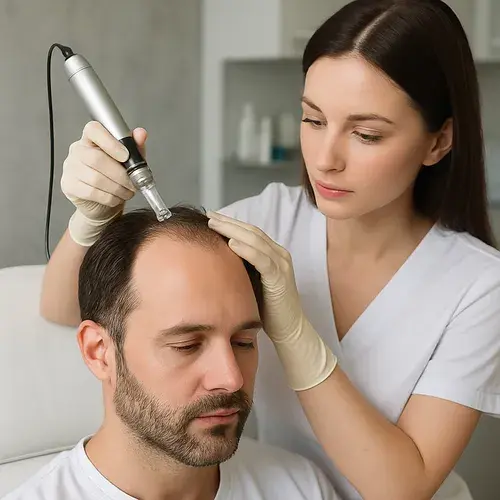Non-Surgical Treatments for Hair Loss
Explore effective non-surgical hair loss treatments like PRP therapy, low-level light therapy, and hair-stimulating tablets that boost growth with minimal risk and quick recovery.

Hair loss can be a distressing condition, affecting both men and women. While surgical options like hair transplants are available, many individuals prefer non-surgical treatments due to their lower risk and recovery time. In this article, we will explore the various non-surgical treatments for hair loss, their mechanisms, benefits, and limitations. Understanding Non-Surgical Hair Loss Treatments Non-surgical hair loss treatments are designed to stimulate hair growth, improve hair density, and mitigate further hair loss without the need for surgery. These treatments are ideal for individuals experiencing receding hairlines, thinning hair, or bald patches. They offer a range of benefits including quick recovery times and minimal discomfort. Platelet-Rich Plasma (PRP) Therapy One of the most popular non-surgical treatments is Platelet-Rich Plasma (PRP) therapy. This treatment involves drawing a patient's blood and then processing it to separate the platelets from other blood components. The platelet-rich plasma is then injected into the scalp where it stimulates hair growth by releasing growth factors that promote cell division and tissue repair . PRP therapy is particularly effective for male and female pattern hair loss. It is a quick and pain-free procedure that offers fast-acting results. Many quality hair loss clinics offer free initial consultations to determine the right level of treatment for each patient. Low-Level Light Therapy (LLLT) Low-Level Light Therapy (LLLT) is another non-surgical treatment that uses low-intensity light to stimulate hair follicles. This therapy was first discovered in 1960 and has since become a popular and effective hair growth treatment for both men and women . LLLT works best for illness-related, post-menopausal, or postpartum hair loss. However, it is not recommended for individuals with severe or total baldness as it cannot revive dead hair follicles. This treatment is generally well-tolerated and can be used in conjunction with other non-surgical treatments. Hair-Stimulating Tablets Hair-stimulating tablets are oral medications designed to promote hair growth. These tablets work by increasing blood flow to the scalp, which helps in nourishing the hair follicles and promoting thicker hair growth . While these tablets can be an effective addition to a non-surgical hair restoration regimen, they should be used under medical supervision. It's important to note that results may vary depending on individual factors such as the severity of hair loss and overall health. Other Non-Surgical Options In addition to PRP therapy and LLLT, there are several other non-surgical options available for hair loss. These include: Trichology Solutions: These holistic approaches focus on rejuvenating the hair and scalp through natural methods. Trichologists use a combination of therapies such as scalp massage, dietary advice, and topical treatments to promote healthy hair growth . Non-Surgical Hair Restoration Techniques: These techniques involve using medical-grade treatments that stimulate hair growth without surgery. They can include topical creams, serums, and other products designed to improve hair density and mitigate further loss . Benefits and Limitations Non-surgical hair loss treatments offer several benefits including: Minimally Invasive: These treatments do not involve surgery, making them less risky compared to surgical procedures. Quick Recovery: Most non-surgical treatments have minimal recovery time, allowing patients to return to their normal activities quickly. Pain-Free: Many non-surgical treatments are pain-free or have minimal discomfort during the procedure. However, it's important to understand the limitations of these treatments: Temporary Results: Non-surgical treatments may not provide permanent results. Hair growth stimulated by these treatments can stop once the treatment is discontinued. Variable Effectiveness: The effectiveness of non-surgical treatments can vary depending on individual factors such as the severity of hair loss and overall health. Conclusion Non-surgical treatments for hair loss offer a range of effective and non-invasive options for individuals experiencing hair thinning or baldness. From PRP therapy to LLLT and hair-stimulating tablets, these treatments can help delay or stop hair loss, improve hair density, and restore confidence. While they may not provide permanent results, they are a valuable alternative to surgical procedures due to their quick recovery times and minimal discomfort. If you are considering non-surgical hair restoration options, it is advisable to consult with a healthcare professional to determine the best course of treatment for your specific needs.
Need Professional Consultation?
Our professional doctors will provide detailed hair and scalp analysis and develop personalized treatment plans.
Book Consultation Now